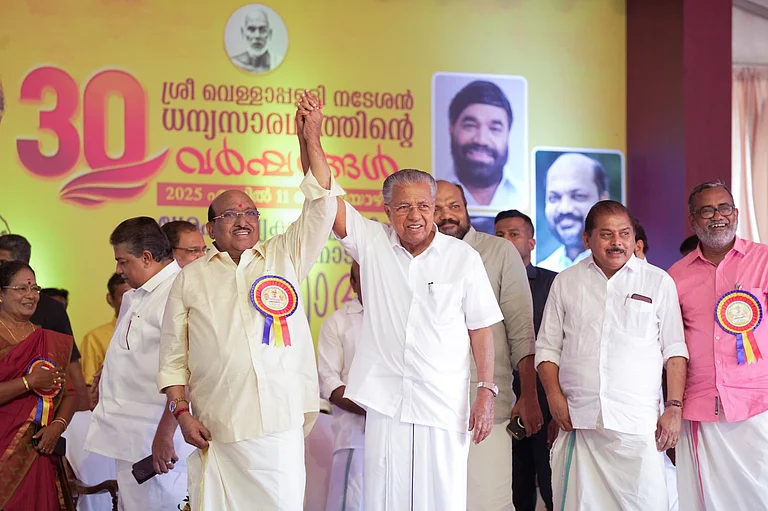I am a working President, not a rubber stamp President,' quoth Mr K.R. Narayanan, and sent a shock wave through Delhi's political fishbowl. Under his presidency, he went on to elaborate, Article 356 would be used only when there was clear evidence that the constitutional machinery had broken down. As if that were not sufficiently explicit, he made a pointed reference to his decision to return the advice given by the I.K. Gujral government to him to dissolve Mr Kalyan Singh's government in UP last Autumn.
Nor, Mr Narayanan felt, was the President's role limited to overseeing the use of 356. In his televised talk with N. Ram, editor of Frontline, he asserted that it was the President's duty to guide the government of the day on the issues it had to face, especially where these impinged upon the functioning of the Constitution and the State. Perhaps boldest of all, he gently suggested that when such advice was in line with the feelings of the people, governments would be well advised to heed the President's advice.
Predictably, Mr Narayanan's views have aroused a storm of speculation. Is he trying to redefine the role of the President in the Indian Constitution? Is he claiming a guardianship role for the President that makes him in some way superior to Parliament? If so, he is clearly out of line. The Indian Constitution is modelled on that of Westminster, we are reminded. There, the Sovereign's right to veto legislation or ignore the advice of his or her council of ministers lapsed almost two centuries ago.
The criticism is not completely off the mark, and the doubts are not unjustified, given the troubled history of the Presidency in our country. But such doubts are uncalled for on this occasion. For Mr Narayanan has clearly spelt out the limits of the President's role as he sees it. He has contrasted his notion of a working President with not only a rubber stamp President, but also an executive President. By the latter, he means a President, like the US President, who exercises administrative power in his capacity as the head of the executive. What is more, the working Presidency he has defined is not just something that falls arithmetically in between these two extremes. This President has no executive power. He cannot command the administration or the armed forces to do anything on his own, even in an emergency. His role is to act as the guardian of the Constitution, to advise and to warn. In short, far from being something new, Mr Narayanan's concept of the Presidency is as old as parliamentary democracy. For it is precisely what Walter Bagchot, perhaps the greatest constitutional theorist of all time, defined as being the role of the constitutional monarch.
What made his formulation sound new are the radically changed circumstances in which he made it. Democracy works on not just written but, more importantly, unwritten rules and conventions. What's more, it is not an end in itself but a means to an end, which end being the welfare of the governed. So long as the institutions of democracy—the legislature, the executive and the judiciary—perform their functions scrupulously, with due regard for the provisions of the Constitution, the interests of the people are automatically safeguarded and the President or Monarch remains a rubber stamp. It is only when one or more of them stop doing so that the latent role of the President or Monarch, as Bagchot defined it, gets activated. Mr Narayanan's remarks, both with regard to the state of the nation, of politics, and politicians, show the time for such activation has arrived.
No one who has studied the confusion and turmoil that prevails in Indian politics can doubt for a moment that this is indeed so. Since the end of Congress dominance, there have been as many as 35 parties in the national Parliament. The national government has been made up by coalitions of anything from 14 to 18 political parties. Nor is there a likelihood of the number of partners coming down, for each of these little parties now enjoys a secure vote base in its home state or states, and is able to transform that support into a few seats at the Centre. In such circumstances it was only to be expected that some of the coalition partners would try to use their power at the Centre to settle scores with rivals in their home states.
During the UF regime, Mr Mulayam Singh Yadav tried to keep the BJP out of power in UP by hook or by crook, and would have succeeded had the President not demurred. A far more dangerous situation was averted when a Congress, rendered berserk by the Jain commission report, demanded that Mr Gujral dismiss the DMK government as the price of its support. It is to Mr Gujral's eternal credit that he did not weaken before the temptation. But his hands were no doubt strengthened by his foreknowledge of how the President, Mr Narayanan, was likely to react to such a suggestion.
Deciding when and when not to invoke Article 356 to dismiss an elected state government is the easier part of the challenge that a President is likely to face in the period of transition from dominant party to bi-polar, coalition democracy. The harder part is to decide when and when not to accede to the request of a reigning Prime Minister to dissolve the Lok Sabha. Given the confrontation between Ms Jayalalitha and the BJP, this challenge may be only days away. British parliamentary practice, usually so precise elsewhere, is a shade opaque on this. Normally the monarch must be bound by the advice of the council of ministers. But should he be so when that council has clearly lost the support of the house, perhaps as a result of defections from the ruling coalition?
In 1924, when this question came before the British monarch, the British political establishment found a typically innovative way to evade it. When the Liberal party withdrew support from Ramsay Macdonald's minority Labour government, he did not ask for dissolution but simply tendered his resignation. The King then asked the leader of the second largest party, the Conservatives, to form the government. But Mr Baldwin accepted on condition that he was allowed to dissolve the Parliament and hold a fresh election.
What neither the King, nor Mr Baldwin contemplated even for a moment, was to form a government which would depend for its majority on the very people who had pulled the Labour government down. Yet, that is precisely the signal that Ms Jayalalitha is waiting for to desert the BJP coalition. And, unlike the principled Mr Baldwin, that is precisely the signal that power-hungry politicians in the Congress are trying to persuade Mrs Sonia Gandhi to send out. Mr Vajpayee has said more than once that were this to happen, he will call for a fresh election. Should this contingency arise, given what Mr Narayanan has already done during his year of Presidency, I am confident the country is in safe hands.























